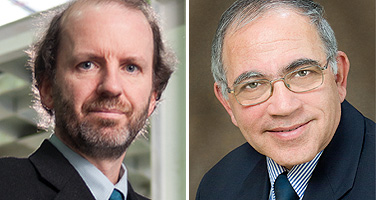News
Reinhorn, Bruneau receive ASCE awards

Michel Bruneau (left) and Andrei Reinhorn have won prestigious national awards from the American Society of Civil Engineers.
Two faculty members in the Department of Civil Engineering have won prestigious national awards from the American Society of Civil Engineers (ASCE), the country’s oldest national engineering society representing more than 144,000 civil engineers worldwide.
ASCE has chosen Andrei M. Reinhorn, Clifford C. Furnas Professor of Structural Engineering, to receive the 2011 Nathan M. Newmark Medal. Michel Bruneau, professor of civil, structural and environmental engineering and former director and deputy director of UB’s MCEER, has been selected to receive the 2011 George Winter Award.
The Newmark medal is given to an ASCE member who, through contributions in structural mechanics, has substantially strengthened the scientific base of structural engineering. The award winner is jointly selected by the members of the Board of Governors of the Engineering Mechanics Institute and by the retired chairs of the Structural Engineering Institute Executive Committee.
Reinhorn is the third UB faculty member—after George C. Lee and Tsu T. Soong—to receive the award in the past 11 years, a unique achievement among competing institutions during this period.
He is being recognized for his outstanding contributions to the development of experimental and analytical methods in structural dynamics and for his design of response-control systems for earthquake-resistant buildings, as well as contributions to quantify earthquake-resilient communities.
The George Winter Award—named for Winter, the world-renowned teacher and researcher at Cornell University who died in 1982—recognizes the achievements of an active structural engineering researcher, educator or practitioner who best typifies Winter’s humanistic approach to his profession, an equal concern for matters technical and social, for art as well as science, for soul as well as intellect.
Bruneau is being recognized for his contributions to structural engineering and seismic-hazard mitigation and to creative, fictional literature that tells the hazard mitigation story to a broader audience.
A UB faculty member since 1979, Reinhorn’s most notable contributions to the field of civil engineering are in the development of new modeling techniques for nonlinear structural analysis, structural control of inelastic structures and quantification of disaster resilience of communities. Reinhorn, who also is an investigator with UB’s MCEER (formerly the Multidisciplinary Center for Earthquake Engineering Research), has developed new models and computational approaches for damaged and degrading structures near collapse, which have enabled engineers to design safer buildings. His widely used models offered new analytical concepts in states space and Lagrangian formulations. His computational platforms are widely used by academics and design professionals around the world.
Reinhorn also has developed modeling and solution techniques for structural control and base isolated structures. He pioneered experimental structural control that brought experimentation from small-scale laboratory implementations to the full-scale, real-life realization of controlled structures using active tendon systems in Japan. He also has pioneered many new techniques in shake table testing and advanced experimental techniques.
He was one of the pioneers in defining the disaster resilience of communities and developing ways to quantify it. Using basic principles of process control, he developed a strategy for community decisions corresponding to disasters, recovering from disasters, strengthening and toughening systems, preventing disasters and preparing communities for decisions in future events.
Bruneau’s groundbreaking research on steel plate shear walls has largely shaped current, seismic design requirements for the system. His research on multi-hazard resistant bridge bents has resulted in the development of recommendations for design requirements for composite steel-concrete bridge bents for both seismic and blast loads.
A UB faculty member since 1998, Bruneau has led a large research program on the seismic evaluation and retrofit of steel truss bridges, which began with a comprehensive study of riveted bracing members often used in truss bridge piers. That research was extended with the development of a rocking approach for truss bridge pier retrofit and the development of an eccentrically braced frame with self-stabilizing links that are not subject to lateral torsional buckling and thus can be used in planar piers where lateral bracing is difficult to provide. This work has resulted in seismic design requirements that have been included in various codes and design specifications, including the 2010 Edition of the AISC Seismic Design Provisions.
In addition to the successes of his technical career, Bruneau’s success as a fiction writer particularly suited him for the award. He has written two novels, one in English and one in French, both of which have received critical acclaim. In his latest novel, “Shaken Allegiances,” he tells the story of an earthquake event in an unprepared city and the resulting breakdown of societal systems and exposure of human behavior.

Reader Comments